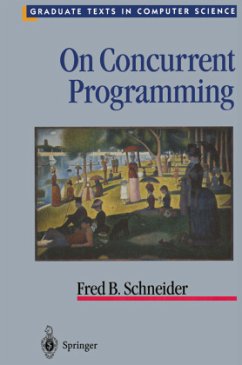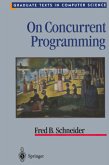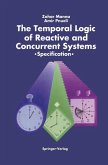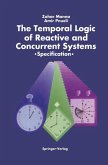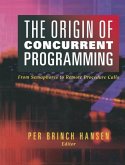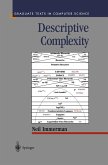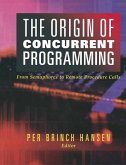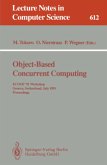Fred B. Schneider
On Concurrent Programming
Fred B. Schneider
On Concurrent Programming
- Broschiertes Buch
- Merkliste
- Auf die Merkliste
- Bewerten Bewerten
- Teilen
- Produkt teilen
- Produkterinnerung
- Produkterinnerung
Concurrent computing is gaining ground in interest as it becomes increasingly feasible to implement distributed computing across networks of workstations. This book, by one of the subject's leading figures, provides a comprehensive survey of the subject beginning with proposotional logic and concluding with concurrent programming. It is based on graduate courses taught at Cornell University and is designed to be used as a graduate text. There are exercises at the end of each chapter to extend and illustrate the main themes covered. Professor Schneier emphasizes the use of formal methods and…mehr
Andere Kunden interessierten sich auch für
![On Concurrent Programming On Concurrent Programming]() Fred B. SchneiderOn Concurrent Programming38,99 €
Fred B. SchneiderOn Concurrent Programming38,99 €![The Temporal Logic of Reactive and Concurrent Systems The Temporal Logic of Reactive and Concurrent Systems]() Zohar MannaThe Temporal Logic of Reactive and Concurrent Systems39,99 €
Zohar MannaThe Temporal Logic of Reactive and Concurrent Systems39,99 €![The Temporal Logic of Reactive and Concurrent Systems The Temporal Logic of Reactive and Concurrent Systems]() Zohar MannaThe Temporal Logic of Reactive and Concurrent Systems84,99 €
Zohar MannaThe Temporal Logic of Reactive and Concurrent Systems84,99 €![The Origin of Concurrent Programming The Origin of Concurrent Programming]() The Origin of Concurrent Programming90,99 €
The Origin of Concurrent Programming90,99 €![Descriptive Complexity Descriptive Complexity]() Neil ImmermanDescriptive Complexity130,99 €
Neil ImmermanDescriptive Complexity130,99 €![The Origin of Concurrent Programming The Origin of Concurrent Programming]() Per Brinch Hansen (ed.)The Origin of Concurrent Programming75,99 €
Per Brinch Hansen (ed.)The Origin of Concurrent Programming75,99 €![Object-Based Concurrent Computing Object-Based Concurrent Computing]() TokoroObject-Based Concurrent Computing39,99 €
TokoroObject-Based Concurrent Computing39,99 €-
-
-
Concurrent computing is gaining ground in interest as it becomes increasingly feasible to implement distributed computing across networks of workstations. This book, by one of the subject's leading figures, provides a comprehensive survey of the subject beginning with proposotional logic and concluding with concurrent programming. It is based on graduate courses taught at Cornell University and is designed to be used as a graduate text. There are exercises at the end of each chapter to extend and illustrate the main themes covered. Professor Schneier emphasizes the use of formal methods and assertional reasoning using notation and paradigms drawn from programming to drive the exposition. As a result, all those interested in studying concurrent computing will find this to be an invaluable approach to the subject.
Produktdetails
- Produktdetails
- Texts in Computer Science
- Verlag: Springer / Springer New York / Springer, Berlin
- Artikelnr. des Verlages: 978-1-4612-7303-5
- Softcover reprint of the original 1st ed. 1997
- Seitenzahl: 496
- Erscheinungstermin: 30. September 2012
- Englisch
- Abmessung: 235mm x 155mm x 27mm
- Gewicht: 753g
- ISBN-13: 9781461273035
- ISBN-10: 146127303X
- Artikelnr.: 39163185
- Herstellerkennzeichnung
- Springer-Verlag GmbH
- Tiergartenstr. 17
- 69121 Heidelberg
- ProductSafety@springernature.com
- Texts in Computer Science
- Verlag: Springer / Springer New York / Springer, Berlin
- Artikelnr. des Verlages: 978-1-4612-7303-5
- Softcover reprint of the original 1st ed. 1997
- Seitenzahl: 496
- Erscheinungstermin: 30. September 2012
- Englisch
- Abmessung: 235mm x 155mm x 27mm
- Gewicht: 753g
- ISBN-13: 9781461273035
- ISBN-10: 146127303X
- Artikelnr.: 39163185
- Herstellerkennzeichnung
- Springer-Verlag GmbH
- Tiergartenstr. 17
- 69121 Heidelberg
- ProductSafety@springernature.com
1 Introduction.- 1.1 Concurrent Programs.- 1.2 Communication and Synchronization.- 1.3 Understanding Concurrent Programs.- 1.4 A Preview.- Historical Notes for Chapter 1.- Exercises for Chapter 1.- 2 Formal Logic.- 2.1 Formal Logical Systems.- 2.2 Propositional Logic.- 2.3 A Predicate Logic.- 2.4 Safety and Liveness Revisited.- Historical Notes for Chapter 2.- Exercises for Chapter 2.- 3 Temporal Logic.- 3.1 Informal Preview.- 3.2 Syntax and Meaning of Formulas.- 3.3 Axioms and Inference Rules.- 3.4 Temporal Logic Applications.- 3.5 About Modal Logics.- Historical Notes for Chapter 3.- Exercises for Chapter 3.- 4 Notation and Logic for Sequential Programming.- 4.1 Notation for Sequential Programs.- 4.2 Reasoning About Program States.- 4.3 Proof Outline Logic.- 4.4 Assignment to Composite Variables.- 4.5 A Predicate Transformer.- Historical Notes for Chapter 4.- Exercises for Chapter 4.- 5 Concurrency and Interference.- 5.1 Specifying Concurrency.- 5.2 Control Predicate Axioms.- 5.3 Interference Freedom.- 5.4 Hiding Control Predicates in Derived Terms.- 5.5 Synchronously Altered and Shared Assertions.- 5.6 Specifying Synchronization.- 5.7 Synchronization and Interference.- Historical Notes for Chapter 5.- Exercises for Chapter 5.- 6 Safety Properties: Invariance.- 6.1 Invariance Properties.- 6.2 Verifying Invariance Properties.- 6.3 Exclusion of Configurations.- 6.4 Direct Use of Proof Outlines.- 6.5 Developing Programs for Invariance Properties.- Historical Notes for Chapter 6.- Exercises for Chapter 6.- 7 Safety Properties with Past Terms.- 7.1 Historical Safety Properties.- 7.2 Past Extensions to Predicate Logic.- 7.3 Verifying Historical Safety Properties.- 7.4 Developing Programs for Historical Safety Properties.- 7.5 Auxiliary Variables.- 7.6 Some Cautions.- Historical Notes for Chapter 7.- Exercises for Chapter 7.- 8 Verifying Arbitrary Temporal Logic Properties.- 8.1 S-Temporal Logic Revisited.- 8.2 Unless Properties and Derivatives.- 8.3 Fairness Assumptions.- 8.4 Reasoning from Fairness Assumptions.- 8.5 Helpful Actions and Eventualities.- 8.6 Liveness for Mutual Exclusion.- Historical Notes for Chapter 8.- Exercises for Chapter 8.- 9 Programming with Fine-Grained Atomic Actions.- 9.1 Pretending Atomicity.- 9.2 Translation-Independent Reasoning.- 9.3 Implementing Condition Synchronization.- 9.4 Programming with the Subset.- 9.5 Synchronization and Interference Revisited.- 9.6 Interlock Instructions.- 9.7 Example: Barrier Synchronization.- Historical Notes for Chapter 9.- Exercises for Chapter 9.- 10 Semaphores, Locks, and Conditional Critical Regions.- 10.1 Semaphores.- 10.2 Change of Variable to use Semaphores.- 10.3 Binary Semaphores and Locks.- 10.4 Split Binary Semaphore Method.- 10.5 Conditional Critical Regions.- Historical Notes for Chapter 10.- Exercises for Chapter 10.- 11 Message Passing and Distributed Programming.- 11.1 Asynchronous Message-Passing.- 11.2 Synchronous Message-Passing.- 11.3 Derivation of Distributed Programs.- 11.4 Shared-Variable Representations.- Historical Notes for Chapter 11.- Exercises for Chapter 11.- 12 Putting It Together.- 12.1 On Languages.- 12.2 Principles for Verifying Safety and Liveness Properties.- 12.3 Proofs Only Increase Confidence.- 12.4 A Tool and Applications.- Historical Notes for Chapter 12.- References.
1 Introduction.- 1.1 Concurrent Programs.- 1.2 Communication and Synchronization.- 1.3 Understanding Concurrent Programs.- 1.4 A Preview.- Historical Notes for Chapter 1.- Exercises for Chapter 1.- 2 Formal Logic.- 2.1 Formal Logical Systems.- 2.2 Propositional Logic.- 2.3 A Predicate Logic.- 2.4 Safety and Liveness Revisited.- Historical Notes for Chapter 2.- Exercises for Chapter 2.- 3 Temporal Logic.- 3.1 Informal Preview.- 3.2 Syntax and Meaning of Formulas.- 3.3 Axioms and Inference Rules.- 3.4 Temporal Logic Applications.- 3.5 About Modal Logics.- Historical Notes for Chapter 3.- Exercises for Chapter 3.- 4 Notation and Logic for Sequential Programming.- 4.1 Notation for Sequential Programs.- 4.2 Reasoning About Program States.- 4.3 Proof Outline Logic.- 4.4 Assignment to Composite Variables.- 4.5 A Predicate Transformer.- Historical Notes for Chapter 4.- Exercises for Chapter 4.- 5 Concurrency and Interference.- 5.1 Specifying Concurrency.- 5.2 Control Predicate Axioms.- 5.3 Interference Freedom.- 5.4 Hiding Control Predicates in Derived Terms.- 5.5 Synchronously Altered and Shared Assertions.- 5.6 Specifying Synchronization.- 5.7 Synchronization and Interference.- Historical Notes for Chapter 5.- Exercises for Chapter 5.- 6 Safety Properties: Invariance.- 6.1 Invariance Properties.- 6.2 Verifying Invariance Properties.- 6.3 Exclusion of Configurations.- 6.4 Direct Use of Proof Outlines.- 6.5 Developing Programs for Invariance Properties.- Historical Notes for Chapter 6.- Exercises for Chapter 6.- 7 Safety Properties with Past Terms.- 7.1 Historical Safety Properties.- 7.2 Past Extensions to Predicate Logic.- 7.3 Verifying Historical Safety Properties.- 7.4 Developing Programs for Historical Safety Properties.- 7.5 Auxiliary Variables.- 7.6 Some Cautions.- Historical Notes for Chapter 7.- Exercises for Chapter 7.- 8 Verifying Arbitrary Temporal Logic Properties.- 8.1 S-Temporal Logic Revisited.- 8.2 Unless Properties and Derivatives.- 8.3 Fairness Assumptions.- 8.4 Reasoning from Fairness Assumptions.- 8.5 Helpful Actions and Eventualities.- 8.6 Liveness for Mutual Exclusion.- Historical Notes for Chapter 8.- Exercises for Chapter 8.- 9 Programming with Fine-Grained Atomic Actions.- 9.1 Pretending Atomicity.- 9.2 Translation-Independent Reasoning.- 9.3 Implementing Condition Synchronization.- 9.4 Programming with the Subset.- 9.5 Synchronization and Interference Revisited.- 9.6 Interlock Instructions.- 9.7 Example: Barrier Synchronization.- Historical Notes for Chapter 9.- Exercises for Chapter 9.- 10 Semaphores, Locks, and Conditional Critical Regions.- 10.1 Semaphores.- 10.2 Change of Variable to use Semaphores.- 10.3 Binary Semaphores and Locks.- 10.4 Split Binary Semaphore Method.- 10.5 Conditional Critical Regions.- Historical Notes for Chapter 10.- Exercises for Chapter 10.- 11 Message Passing and Distributed Programming.- 11.1 Asynchronous Message-Passing.- 11.2 Synchronous Message-Passing.- 11.3 Derivation of Distributed Programs.- 11.4 Shared-Variable Representations.- Historical Notes for Chapter 11.- Exercises for Chapter 11.- 12 Putting It Together.- 12.1 On Languages.- 12.2 Principles for Verifying Safety and Liveness Properties.- 12.3 Proofs Only Increase Confidence.- 12.4 A Tool and Applications.- Historical Notes for Chapter 12.- References.

